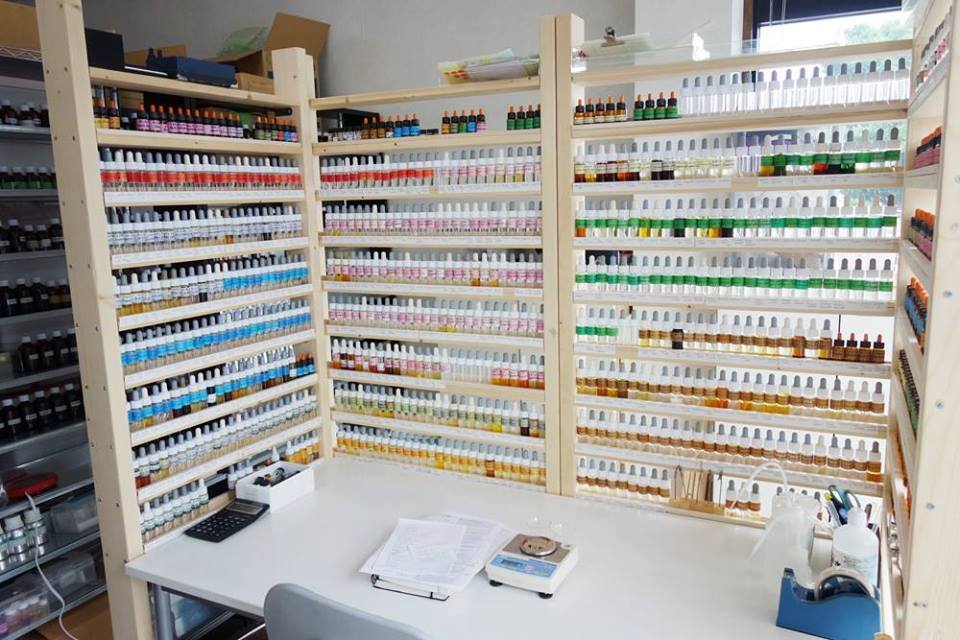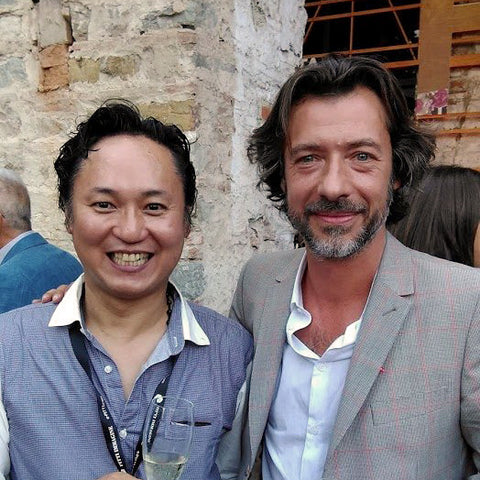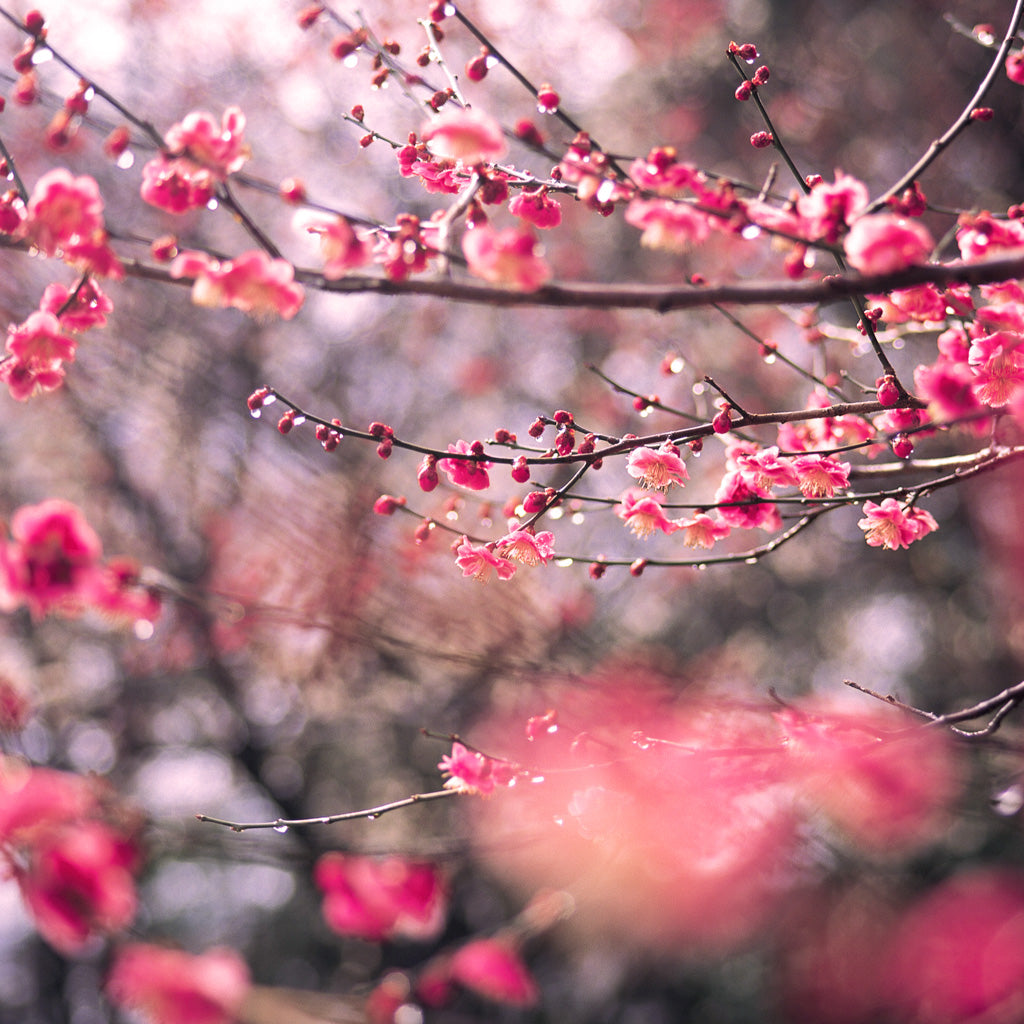September 02, 2016
Inaba san, thank you for the taking the time to do this interview! Would you tell us a bit about yourself?
I am a perfumer and a fragrance writer/journalist in Japan. I used to work as a director of events and exhibitions in my twenties, and those were some long, hard days. A couple of years ago, I left Tokyo, the big city where I had lived for 20 years, and moved to Kyushu, an island located in the southern part of Japan. Now I have settled down with two precious puppies in the countryside by the ocean.
 Above: Tomoo Inaba, Tuberose Farm in India
Above: Tomoo Inaba, Tuberose Farm in India
When did you become interested in perfumes? What made you decide to pursue a career in perfumery?
I grew up in a family with a lot of fragrant flowers and vegetables growing in our garden, and my mom and grandma took great care of them, with love. My mom was especially interested in world plants and she would travel around the world to see them in many botanical gardens. So it was natural for me to learn about those plants and their smells.
Ten years ago, I established a fragrance-distribution company, and soon I realized that I needed to learn what materials and ingredients were used in the fragrances. Otherwise, I couldn't describe them to my customers and make a sale convincingly. Since then, I have been very into fragrances and have published more than 5,200 fragrance reviews (mostly on new releases, but also a few on vintage ones) on my website, profice.jp.
Writing perfume reviews has given me great lessons on perfumery materials and helped me become a better perfumer. I think the more works of other perfumers’ I smell and review, the more critical I become of my own work.
Besides writing reviews, I've been constantly studying books on the subject of perfumery, vintage perfumes and the various plants and materials used in perfumery. To better understand the smell of natural materials, I grow fragrant plants in my garden. These include frankincense, jasminum officinale, ylang ylang, rosa damascena, rosa centiforia, cypress, cassia, patchouli, tuberose, immortelle, cardamon, coriander, pepper, vanilla and many more.
Do you have any formal training in perfumery, or did you learn it by yourself?
I learned perfumery by myself. I started 10 years ago, and I am still learning. I often travel outside of Japan to visit distilleries and farms in different countries such as Madagascar (ylang ylang and some herbs); India (tuberose, jasmine sambac, nagarmotha and more); Sri Lanka (nutmeg, mace and many other spices); Tunisia (orange blossom, geranium and more); and Réunion Island (vanilla, vetiver and geranium). I have been to 25 countries for that purpose so far.
 Above: Ylang-ylang and lemongrass harvesting and distillation in Madagascar
Above: Ylang-ylang and lemongrass harvesting and distillation in Madagascar
Are there any schools in Japan that teach professional perfumery? Do Japanese like to wear fragrances?
One school in Japan teaches professional perfumery. About 90% of Japanese perfumers in this industry are “flavorist”, and 10% design fragrances for bath and toiletry products.
Although there are many fragrance lovers in Japan, most of them are satisfied with typical mainstream designers’ perfumes and only wear fragrances occasionally. As a well-mannered and considerate person in Japan, one only wears a couple of sprays, and tries to make the scents barely noticeable, fearing that too much fragrance might make people around you sick. Also, Japan is a humid country, and when you’re wearing a perfume the scent projection, or spread, becomes stronger.

Can you tell us about the classes that you teach?
I hold several types of classes, which are between 90 and 120 minutes long. In some classes you can learn about the history of perfumes and materials; in others, you learn to create your own perfume or recreate notable vintage perfumes or my original perfumes. They are hobby classes, and my students have no intention of becoming perfumers.
I first learned about you through your fragrance reviews on Facebook. I feel like you know almost everyone in the perfume industry! Is it your passion to meet and make friends with as many perfumers in the industry?
I am passionate about perfumes, and naturally I have many friends who are perfumers. Among them, I have known Stephane Humbert Lucas the longest. I met him at Cosmoprof, a salon products exhibition held in Bologna, Italy 10 years ago. At the time he was starting his own brand, Nez A Nez, with his wife. (Two years after Cosmoprof, the biggest perfume trade show, Exsence, debuted in Milan.)

Tomoo Inaba and Stéphane Humbert Lucas at Pitti Florence 2016
In my opinion, most perfumers don't like to disclose their knowledge. On the contrary, I'd like to open up mine to my friends. I also want to support niche brand perfume houses as much as I can through my online reviews and magazine columns, and also by purchasing their products. As you know, many start-up niche brands don't have much capital or many shops that carry their products.
Nightingale is your debut perfume. Are you pleased with your creation and excited about the launch?
Absolutely, yes! In Japan, you can’t sell your own perfumes or import any perfumes without a license, and you need a lot of money and time to acquire one. People often say that Japanese pharmaceutical laws are the strictest in the world! They consider fragrances and cosmetics the same as medicine. Now, through Zoologist, my perfume can reach different people in the world.
Out of many animals you could create for Zoologist, why did you choose Nightingale as your first inspiration? Are there any special meanings behind it? How do you describe your creation, Nightingale?
Actually, Nightingale was originally created in 2013. It was one of the 50 or more private blends I have created for myself over the years. It’s really lovely and unique, so I decided to enhance and polish it further for Zoologist to publish.
My inspiration for Nightingale came from an ancient Japanese poem, collected in the significant Japanese poem compilation “New Collection of Ancient and Modern Poems” (1205 AD), which goes like this:
かはるらむ 衣の色を思ひやる 涙やうらの 玉にまがはむ
“Soon you will be wearing a black robe and enter nunhood. You will not know each rosary bead has my tears on it.”
The poem was written by Fujiwara no Kenshi (藤原妍子, 994 – 1027), the younger sister of Fujiwara no Shōshi (藤原彰子, 988–1074), who at the time was the Empress of Japan. The Empress had decided to renounce her imperial duties and titles, and take vows as a Buddhist nun. On the day of her ordination ceremony, Fujiwara no Kenshi read to her this poem and subsequently gifted her a wooden box in which she found a rosary made out of agarwood. The box was tied with a ribbon and a plum blossom branch inserted in between.
The strong emotional power of this poem piqued my imagination, and I wanted to translate it into a fragrance. Its central theme led me to choose perfumery materials such as plum blossom, which is associated with the arrival of spring and new beginnings in life, and oud (agarwood). To give the perfume a classical essence, I added patchouli and moss.
In Japan, the arrival of spring is signified by the blossoming of plum trees and the beautiful songs of nightingales, so I thought Nightingale would be the perfect name for this perfume.

Speaking of the “plum blossom” accord, it is something that I have never smelled before in a perfume. Can you tell us more about that?
In Japan, we enjoy "Hanami", the viewing of plum blossoms and cherry blossoms in season. Note that the smell of plum blossom and plum are different; plum blossom is more complex and has an aroma constituent of plum. In Japan, the aroma of plum blossoms has been researched for years, and each fragrance company has their own plum-blossom perfume accord. Plum blossom has several different aromas, like powdery, rosy, fruity and more. I chose the “red plum blossom accord” for Nightingale, which I created seven or eight years ago. In it, some special vintage oils were used, such as ylang ylang from Manila and geranium from Bourbon, distilled before WWII in plum blossom accord and red rose accord respectively.
I have heard that Japanese prefer very light and “unobtrusive” perfumes. Is it true? Would you consider Nightingale a typical “Japanese perfume”, or completely something else?
Yes, that is true, but I never consider the Japanese market when I make a perfume. There is a big difference in preferences between niche perfume lovers and the majority. Zoologist perfumes is well-known for being different and daring, and I believe Nightingale is a good fit in the series.
In my opinion, Nightingale is a unisex perfume more catered towards mature perfume lovers. The combination of rose, oud, saffron and patchouli has some deep and sweet tones, and it’s quite opulent. It might be too strong for most Japanese tastes.
Now that you have a perfume under your name, do you want to design more perfumes for other fragrance houses in the future? Maybe another one for Zoologist? If so, which animal would you consider, and what would it possibly smell like?
Yes, of course. If I get an offer, why not? I’ve always enjoyed making perfumes, and right now I’m collaborating with a senior perfumer who has worked for Givaudan on a brand-new perfume that is not for sale, but just for fun – for both of us.
If I may choose next the animal for Zoologist, it'll be a black bird like a crow or black swan. I'll add patchouli, iris and coumarin and make it a powdery-sweet oriental-themed perfume.
Thank you so much for your time!
Zoologist Nightingale will be available in late October 2016
